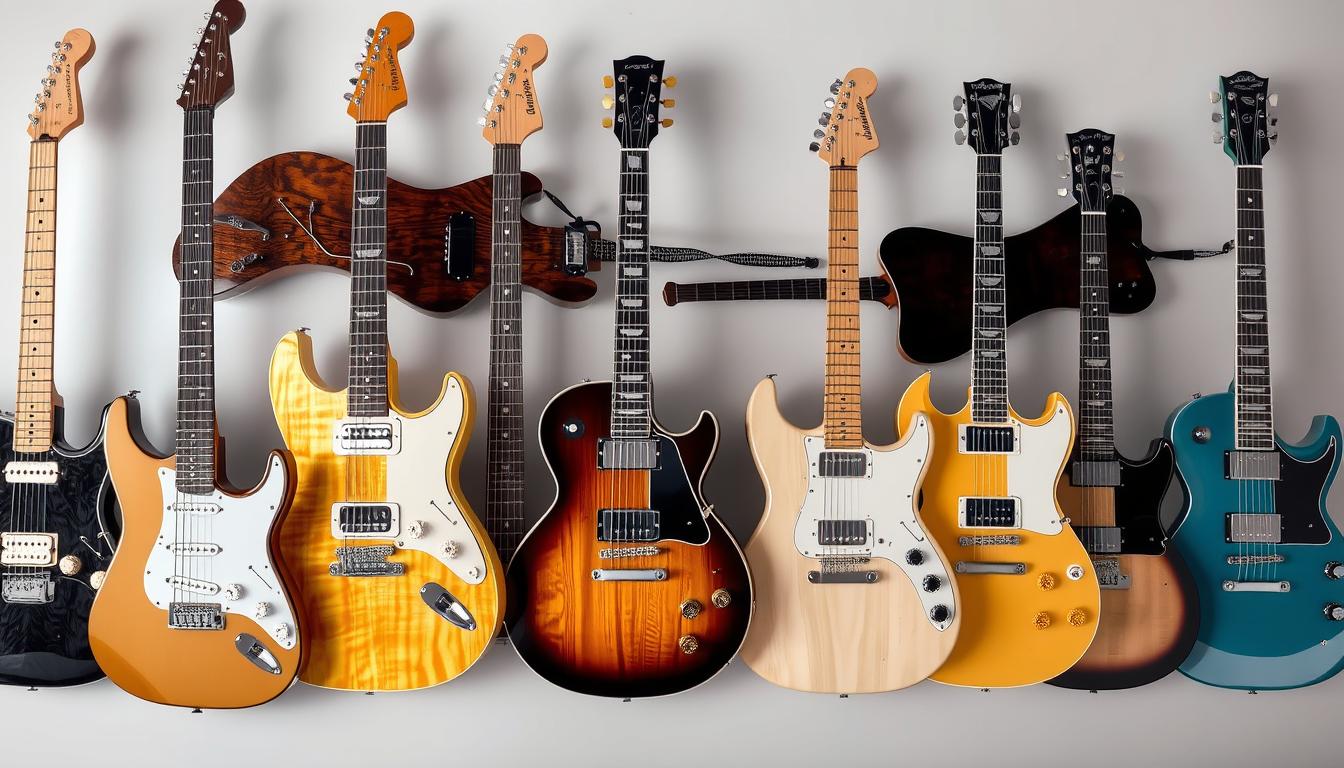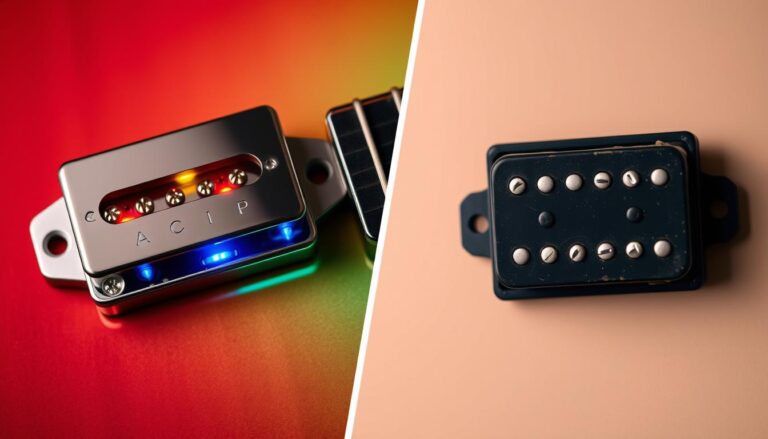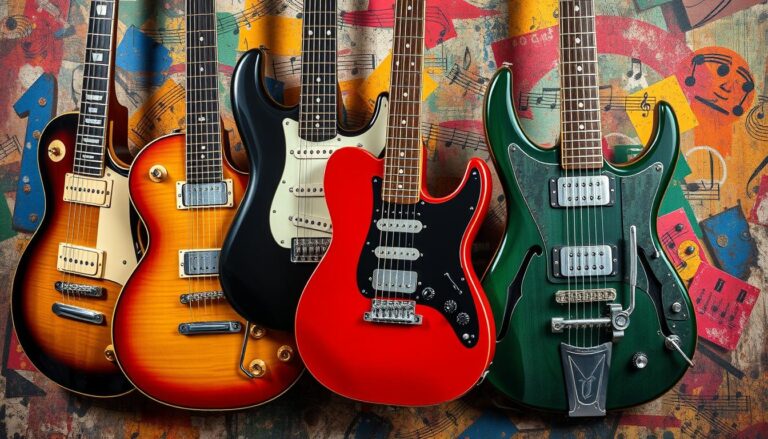Did you know that famous electric guitars can weigh a lot? The Gibson Les Paul Standard weighs between 9.5 – 10 lbs. On the other hand, the Fender Jaguar weighs between 6 – 6.5 lbs. This big difference shows how different guitars can change how they sound and feel to play.
We will dive into the world of electric guitar body styles. We’ll look at how they affect the sound and feel of the guitar. We’ll also talk about different types of electric and acoustic guitar body shapes and their unique qualities.
Key Takeaways
- Electric guitar body shapes significantly impact tone and playability.
- Different woods used in guitar construction influence tone due to varying densities and resonant frequencies.
- Guitar body shapes, such as solid body, semi-hollow, and hollow body, offer distinct tonal characteristics.
- Weight distribution and ergonomics play a critical role in reducing strain and fatigue during performances.
- Understanding the relationship between guitar body shapes and tone can help musicians choose the right instrument for their needs.
- Acoustic guitar body shapes and electric guitar body styles have unique characteristics that cater to various musical genres and player preferences.
- Guitar body shapes, including guitar body styles, are essential for achieving the desired sound quality and playability.
Introduction to Guitar Body Shapes
We’re excited to talk about guitar body shapes and why they matter in music. There are many types, like dreadnought, jumbo, parlor, and concert. Each has its own sound, volume, and how it feels to play.
When picking popular guitar body designs, you have lots of choices. Some players like different guitar body contours for sound or style. Others go for customized guitar body shapes to make their guitar unique.
What Are Guitar Body Shapes?
Guitar body shapes are about the guitar’s physical look and size. This includes length, width, and depth, plus the neck and headstock shape.
Importance of Body Shapes in Sound
The guitar’s body shape greatly impacts its sound. For instance, dreadnoughts are loud and bold, while concert guitars are balanced and intimate.
Overview of Major Styles
Popular shapes include dreadnought, grand auditorium, and grand concert. Each style has its own traits, fitting different music and playing styles.
In summary, guitar body shapes are key to a guitar’s sound and feel. Knowing about the various shapes helps guitarists pick the right one for their music.
The Influence of Wood on Guitar Shape
The wood used in guitar bodies greatly affects the sound. Different woods like mahogany, maple, and spruce create unique tones. For example, mahogany gives a loud sound with bright highs and a strong mid-range. Maple, on the other hand, offers sustain and a sharp, bright sound.
The choice of wood is key for iconic guitar body silhouettes. Unique guitar body configurations come from mixing different woods. This leads to a wide range of sounds. Solid and hollow bodies are among the top guitar body variations, each with its own sound.
Common Woods Used in Guitar Bodies
Mahogany, maple, and spruce are common in guitar bodies. Each wood has its own sound. Mahogany offers a warm, rich sound, while maple provides a bright, crisp one.
How Wood Type Affects Tone
Wood type changes the tone in several ways. Different woods have different densities, affecting sound wave resonance. For instance, maple’s density gives a brighter sound, while mahogany’s offers a warmer one.
Comparing Solid vs. Hollow Bodies
Solid and hollow bodies are two main types. Solid bodies are one piece of wood, while hollow bodies have an empty center. The choice depends on the desired sound and playability. Solid bodies are known for their sustain, while hollow bodies are loved for their warmth.
Popular Electric Guitar Body Shapes
We’re excited to share the top electric guitar body shapes loved by musicians for years. These designs are known for their great sound and ease of play. The Stratocaster, Les Paul, and Telecaster are the most popular, each with its own special sound.
These three models are favorites for their versatility, comfort, and looks. The Stratocaster, made by Fender in 1954, has a unique double cutaway design. The Les Paul, from Gibson in 1952, has a thick body for better sustain and tone. The Telecaster, first called the Broadcaster, was the first solid-body electric guitar in the early 1950s.
Stratocaster: Versatility and Comfort
The Stratocaster is great for many music styles. Its body shape and edges make it easy to hold and play.
Les Paul: Aesthetic Appeal and Warm Sound
The Les Paul is known for its warm sound and looks. Its thick body and humbucker pickups give it a unique sustain and tone.
Telecaster: Brightness and Twang
The Telecaster is loved for its bright, twangy sound. It’s a favorite among country and rock players. Its design and bolt-on neck add to its unique sound and playability.
These iconic guitar shapes have shaped the music world. Knowing their features helps musicians find the perfect guitar for their style and sound.
| Guitar Model | Introduction Year | Body Type |
|---|---|---|
| Stratocaster | 1954 | Solid body |
| Les Paul | 1952 | Solid body |
| Telecaster | 1950 | Solid body |
Scale Length and Its Relation to Shape
The scale length of a guitar greatly affects its playability and sound. Different lengths can change the tone and feel of the instrument. Customized shapes, iconic silhouettes, and unique designs all rely on the scale length for their sound and playability.
The Fender Stratocaster has a 25.5-inch scale length, while the Gibson Les Paul has a 24.75-inch scale. These lengths change the string tension, which affects the tone and playability. A longer scale, like the Stratocaster’s, gives a brighter tone. A shorter scale, like the Les Paul’s, offers a warmer tone.
Here are some common scale lengths found in popular guitar models:
- Fender Jaguar / Mustang / Duo Sonic: 24 inches (610 mm)
- Gibson Les Paul / SG / Designer / ES: 24.75 inches (629 mm)
- Fender Stratocaster / Telecaster / Jazzmaster / Lead: 25.5 inches (648 mm)
In conclusion, the scale length is key when choosing a guitar. It’s important to understand how scale length and shape work together. This knowledge helps us appreciate each guitar’s unique qualities and choose the right one for us.
| Guitar Model | Scale Length |
|---|---|
| Fender Stratocaster | 25.5 inches |
| Gibson Les Paul | 24.75 inches |
| Fender Jaguar | 24 inches |
Body Thickness and Its Effect on Tone
The thickness of a guitar body greatly affects its tone and sound quality. When looking at different guitar body shapes, it’s key to see how thickness changes sound. Thinner bodies give a brighter, more crisp sound. Thicker bodies offer a warmer, richer sound.
Popular guitar designs balance body thickness with scale length and wood type. The shape of the body also impacts resonance and sustain. Exploring guitar body shapes helps us understand how they affect sound and playability. You can learn more about acoustic guitar body sizes and their tone impact.
When checking body thickness, consider these points:
- Standard thickness measurements and their tone impact
- The sound differences between thin and thick bodies
- How body thickness affects resonance and sustain
Understanding body thickness and tone helps musicians choose the right guitar. Whether you prefer the warm, rich sound of a thicker body or the bright, crisp sound of a thinner one, there’s a guitar for you.
Ergonomics and Guitar Shapes
Ergonomics are key in guitar design, affecting how easy it is to play and how comfortable it feels. Guitar body shapes must be designed for comfort, so musicians can play for hours without getting tired. The design of acoustic guitar body shapes and electric guitar body styles should match how the player interacts with the instrument.
Some guitars, like the Stratocaster and Les Paul, have bodies that fit well against the player’s body. These shapes and cutaways help players reach the upper frets easily. This makes playing complex chords and melodies simpler. It’s also important for the guitar to be balanced in weight and style, as an unbalanced guitar can be hard to play.
The neck and headstock design also affect the guitar’s ergonomics. A well-designed headstock makes tuning easier. A neck that feels good in your hand can reduce fatigue and discomfort. Guitar makers aim to create instruments that look great and feel comfortable to play.
Brands like Music Man and PRS focus on ergonomic designs for comfort and playability. Their dedication to quality has earned them high praise from musicians and fans.
Unique Body Shapes in Electric Guitars
We’re excited to share unique body shapes in electric guitars. These customized guitar body shapes give a special sound and look. With more iconic guitar body silhouettes, makers now offer many unique guitar body configurations. This meets different musical tastes and styles.
Explorer and Firebird: Bold Designs
The Explorer and Firebird stand out with their bold designs. They have shapes that are different from usual guitars. The Explorer looks futuristic, and the Firebird has a retro feel. They’re favorites for those who want to be different.
Jaguar and Jazzmaster: Specialty Models
The Jaguar and Jazzmaster offer a special playing feel. They have unique shapes and designs for certain music styles. The Jaguar is sleek and modern, loved by indie and alternative rock fans. The Jazzmaster has a vintage look, perfect for jazz and blues players.
Market Trends in Unique Shapes
The demand for unique guitar body shapes is rising. Many makers now offer a variety of designs. From customized guitar body shapes by small brands to iconic guitar body silhouettes by big names, there’s a growing interest. As music evolves, we’ll see more creative and unique guitar body configurations.
How Body Shape Affects Amplification
The shape of an electric guitar’s body greatly influences its sound. Different guitar body shapes can change how the instrument sounds. For example, the Stratocaster and Les Paul have distinct tones.
Each popular guitar body design has its own sound and feel. The Stratocaster is known for its versatility and comfort. On the other hand, the Les Paul is famous for its beauty and warm sound. The body shape also affects the type of pickups used, like single-coils or humbuckers.
The body shape of an electric guitar can greatly impact its sound. Different shapes can change the volume, sustain, and tone. Choosing the right shape is key to finding the perfect guitar for your style and music.
| Body Shape | Tonal Characteristics | Pickup Configuration |
|---|---|---|
| Stratocaster | Bright, crisp sound | Single-coil pickups |
| Les Paul | Warm, rich sound | Humbucker pickups |
Customization: Personalizing Your Guitar Shape
We know every musician is unique. That’s why we offer many ways to customize your guitar. You can choose from customized guitar body shapes to iconic guitar body silhouettes. We help you make a guitar that shows off your style and sound.
Popular Modifications and Upgrades
Some popular things to customize include:
- Changing the body shape for better playability and comfort
- Upgrading the neck and fretboard for better tone and sustain
- Adding custom pickups and electronics for more sound options
Body Shape Customization Options
Our expert luthiers can design and build a unique guitar body configuration for you. Whether you want a classic look or something new, we can make it happen. We’ll create a guitar shape that makes you stand out.
The Role of Genre in Choosing Body Shapes
Choosing the right guitar is all about the music you play. Different music styles need different sounds and feels. For example, rock and blues fans want loud, powerful sounds from electric guitars. Jazz and folk players prefer the softer tones of acoustic guitars.
For more on guitar body shapes and music styles, check out this guide on electric guitars. The right guitar body shape can change how your guitar sounds and feels. Knowing how music styles affect guitar choices is key for finding the perfect fit.
Here are some music styles and their favorite guitar shapes:
- Rock: Les Paul, Stratocaster
- Blues: Telecaster, Gibson ES-335
- Jazz: Hollow body, Archtop
These guitar shapes are made to meet each genre’s sound needs. This way, musicians can get the right tone and feel for their music.
In short, the music you play greatly influences your guitar choice. By knowing what each genre needs, you can pick the best guitar for your sound and style. This ensures you get the best sound and feel from your guitar.
Conclusion: The Interplay of Shape, Tone, and Playability
In our look at electric guitar body shapes, we’ve seen how they affect sound and play. The Telecaster’s bright sound and the Les Paul’s warmth show each shape’s unique sound. Musicians can use these sounds to share their music in new ways.
Summarizing Key Points
Let’s wrap up what we’ve learned. We found out that wood, scale length, and thickness all impact a guitar’s sound. Also, the shape and feel of the guitar are key to playing comfortably. This lets musicians focus on their music, not on how to hold the guitar.
Encouraging Exploration of Body Shapes
We urge all musicians to try out different guitar shapes. See how they fit with your playing style. Find the shape that matches your music goals. The mix of shape, sound, and feel is exciting.
Final Thoughts on Choosing the Right Shape
Remember, picking a guitar shape is more than looks. It affects your sound and how comfortable you are playing. Learn about each design’s features. Let your taste and music style help you choose the right guitar.




